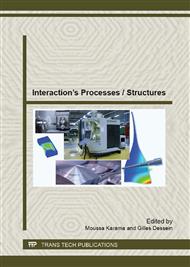p.29
p.39
p.49
p.59
p.69
p.79
p.89
p.99
p.107
Numerical Simulation of Springback during an Operation of V-Bending, Application to Titanium and Aluminum Sheets
Abstract:
Generally, the sheet metal forming processes by plastic deformation are difficult to control owing to the multiple phenomena that can occur and disrupt the operation: the springback, the localization, the wrinkling, etc. The springback is a physico-mechanical phenomenon due to the return of the elastic energy stored during the loading phase, which leads to a change in the dimensions of the formed part. In fact, the improvement of the operation presents some complications because an important number of parameters that affect the springback and that can be accurately understood by the use of finite element analysis. In particular, the springback appears so prominent in the bending operations; this mode of deformation is the focus of this work which consists of two main parts: - Mechanical characterization of two alloys frequently used in aerospace manufacturing: aluminum 1050A and titanium T40 commercially available in the form of cold-rolled thin sheets. The conventional and rational curves are obtained by using a tensile test machine (Instron 50kN). - Finite element simulation of a V-bending operation of sheet metal with both materials. This study allows us to calibrate the numerical procedures that could be included in more complex operations.
Info:
Periodical:
Pages:
69-78
Citation:
Online since:
May 2013
Price:
Сopyright:
© 2013 Trans Tech Publications Ltd. All Rights Reserved
Share:
Citation:


